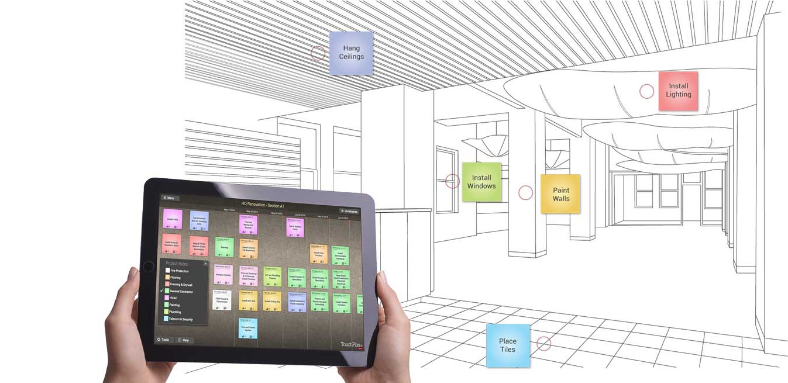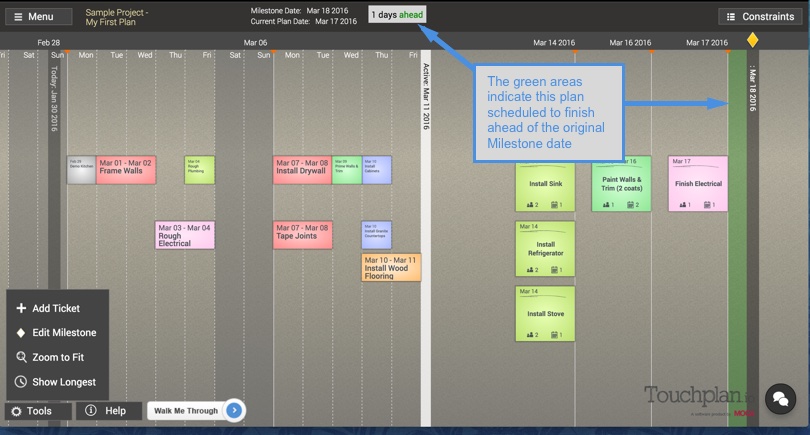
To help get your year started right, spend some time in Touchplan’s Lean Learning Center. There are lots of great articles to help with understanding Lean Construction and the Last Planner® System.
Today we wanted to highlight our Best Practices Guide to the Last Planner® System.
As most of you know, the Last Planner® System, or Last Planner®, is a short-term production planning system designed to produce predictable work flow and rapid learning in programming, designing, commissioning, and construction of projects. The name refers to the person on site who can ensure predictable work flow downstream. Owners, clients or construction companies, can use Last Planner® to achieve better performance in design and construction through increased schedule/program predictability.
Last Planner® was developed by Glenn Ballard and Greg Howell.
There are five steps to Last Planner® are:
- Master Scheduling
- Phase Scheduling
- Make Work Ready Planning
- Weekly Work Planning, and
- Learning
We have articles available for each of these steps. They include tips for milestone scheduling and pull planning, directives on how to ‘make work ready,’ as well as common mistakes to avoid in weekly work planning and percent plan complete evaluation.

An effective facilitator can be the difference between a productive planning session and a frustrating waste of time. Your job, as facilitator, is to move along the collaboration without taking over and running the meeting. You should facilitate an effective conversation and not dominate the discussion. If you manage the meeting successfully you will keep conversations on track and ensure that all team members’ voices are heard.
Here are 6 steps to help you facilitate better in your next meeting:
Prepare
Go over the specs of the project. Familiarize yourself with the scope of work and objectives. Preparing ahead will help you keep the big picture in focus. You will be in a better position to guide the group in the task at hand.
State Objectives
Begin the meeting with a clear explanation of the goal for the meeting. Whether it is a planning meeting, a strategy session, or a 6 week look-ahead meeting it is important to get everyone on the same page with the goals for the meeting.
Engage the Group
Pay attention to the group dynamic. Are there people talking over others? Is someone not speaking up? Is no one talking? Use your role to start and maintain the conversation. Increase interaction between group members to achieve the full benefits of the collaborative process. Balance the voices being heard and keep people talking.
Maintain Focus
Keep the conversation focused on the task at hand. Large planning sessions can easily devolve into side conversations. If focus is waning in the group, take the chance to reiterate the objectives and put people back on task.
Manage Dysfunction
As a facilitator you will run into unproductive behavior. You will need to address group dysfunction on a case by case basis. You can redirect attention with appropriate humor, or call a break if you are losing the room. Do these things before dysfunction zaps all the momentum out of your meeting.
Resolve Disagreement
Nip fights in the bud. It does not take much for minor disagreements to spiral out of control. If you see a problem, say something.

Take a minute today and head on over to Capterra Construction Management blog. “The Ultimate Guide to Project Management Methodologies for Construction” features our very own Michael Sullivan.
Continue reading “Lean Construction Management”

Last week I sat down with our in-house Lean construction expert Michael Sullivan. Michael has 24 years of contract and construction project management experience. This experience serves him well here at Touchplan when he leads our clients through the pull planning sessions and weekly progress meetings.

As we kick off our new blog as a place to discuss all things construction management and smart planning – we will also be using this space to communicate the latest changes to the application.
The newest release involves the following updates:
New Feature: Guide Lines on Columns
Creating pull plans has been simplified for your team. We’ve added grid lines to the space while you are sequencing your tasks – the lines help the team keep columns clearly defined and line up tickets more easily.
New Feature: Project Level Constraints
Constraints are now at the project level – so you can access the same constraint in multiple plans. Create a constraint in one plan and it will be available in all the plans. This allows your team to track tasks that are dependent on them. Anyone can connect any ticket to any constraint to ensure they stay in sequence.
Date Calculation: Plan on schedule to finish early
As your team works through the project you can see the impact of your changes to the overall completion date of your milestone. When your schedule is planned to finish prior to your original milestone you will see a green area to the left of the Milestone. The dates on the pull side will be recalculated from that early finish date.
Learn more during our demo on Tuesday or Thursday this week at 1pm EST or click here to schedule your a 1-on-1 demo with one of our application specialist.

Ok. When it comes to planning, maybe the concept of sourcing ideas from a large online community (the definition of crowdsourcing) is a bit extreme. That being said, if your project team isn’t actively part of your planning process, you are missing out on some huge benefits. Continue reading “Crowdsource your Plans”

Consistently finish ahead of schedule and under budget with less stress and fewer problems.
Imagine finishing your project weeks, if not months, ahead of schedule, at costs well below budget, with owners and project teams that are elated at just how well everything falls into place. Now imagine doing this consistently while being less stressed, experiencing few surprises and regularly being home in time for dinner. Too good to be true? Actually, it’s a real thing, and it comes from running smarter projects.
Continue reading “Run Smarter Projects”

Why should you add technology to the Last Planner® System? Touchplan makes your life easier by getting rid of your planning headaches. No more stickies falling off the site trailer wall or taking pictures then translating to MS Excel or Primavera. Create your pull plan in Touchplan and take it with you on your Ipad or laptop wherever you go. Last planners to a project have full visibility to project needs, and can continually monitor, update, and maintain tasks and promises in a real-time, collaborative setting.
Continue reading “Last Planner® System and Touchplan”

The biggest fear of implementing Lean, is that the front end planning will only serve to increase the cost of the project. It is true that the initial Lean planning is more expensive than traditional models. However, the time and money put into planning creates big savings in both over the life of the project. Lean is a long term strategy.
Where do the savings come from?
- Fewer Bottlenecks. Last Planner® allows you to identify the places where work stoppages are likely to occur. When you know where a problem will exist, you can plan accordingly and avoid it. The planning system allows you to work out the contingencies and prevent idle time on site.
- Smarter allocation of Project Capital. Last Planner® also makes sure that you are not spending money on resources until they are immediately necessary for the task at hand. This system wide approach is far more effective at lowering your cost, because it eliminates waste along the entire production stream as opposed to at individual points or problem areas.
- Reduction in the amount of Rework. Work is done at the last appropriate moment. Once the project has begun these savings continue because we complete work only when it is required. This prevents damaged product that would require rework or replacement.
- Correct staffing numbers. The system works because it relies on the expertise of crew leaders to set the work timelines and numbers. This improves predictions of labour required, and prevents you from having to call in more people, or send guys home.
Last Planner® System Reduces Supervisor Stress
Talk to your boss about all the ways Last Planner® will make his job easier. Lean construction takes a lot of the headaches out of the construction process. It does this in the following ways:
- It identifies potential problems before they become obstacles in the project
- Makes sure that bad news is learned at the earliest possible time
- Uses social pressure to motivate teams for faster completion
- Develops supervisory skills among subcontractors, which in turn
- Reduces the load on management
All of these benefits serve to create a more predictable and reliable production program.

There are many reasons why subs should be interested in the Last Planner® System. Here are the top three reasons that subcontractors should be equally invested in tackling a project the lean way.
Continue reading “Three reasons Subcontractors love Last Planner®”



